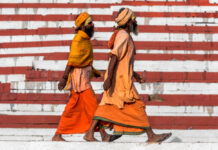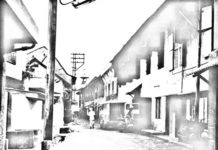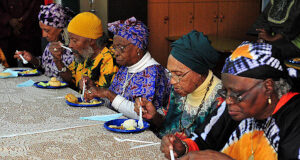In the lobby of San Francisco’s opulent Fairmont Hotel, Ephraim Isaac wasn’t hard to spot. He was the one wearing the white djellaba (robe), natalah (fringed scarf) and gobah (wedding cake-shaped head covering).
He looked like a Yemeni prince.
Isaac was there, along with Jews from Asia, Africa, Europe and Latin America, to participate in the third annual Be’chol Lashon Think Tank, which gathers together representatives of the world’s farthest-flung Jews.
The S.F.-based Institute of Jewish and Community Research sponsored last weekend’s event. Under the leadership of Gary Tobin, the institute launched Be’chol Lashon to help nurture Jewish communities of color in the United States and around the world.
The annual conference provides opportunities for cultivating Jewish fellowship, most of it in a chorus of lilting accents.
Isaac was one of the key participants. He is a longtime Harvard professor, founder of that university’s Department of Afro-American Studies, fluent in more than a dozen languages and a renowned scholar of Ethiopian and Yemeni Jewry.
He’s also fervently religious and a drum major for Jewish observance. “Judaism is not a race or ethnicity,” he affirms. “It is a religion based on the revelation at Mount Sinai. The gates are open as long as you’re willing to embrace it and practice it.”
Though born in Ethiopia to an impoverished family, Isaac was brought up in the Yemeni tradition of intense Jewish scholarship. He came to the United States in the 1950s and soon broadened his academic horizons, becoming the first Ethiopian to graduate from Harvard.
He has since been a strong advocate for black-Jewish relations and was an adviser to the Israeli government on its follow-up to Operation Exodus, during which thousands of Ethiopian Jews were resettled in Israel.
Also attending the conference was Romiel Daniel, a Bombay-born Jew representing the small but ancient Jewish community of India. Though now a resident of New York (he serves as president and occasional cantor for the Rego Park Jewish Center in Queens), he maintains strong ties to the dispersed Indian Jewish community.
“There are 300 Indian Jews in the United States,” he says. “But there are 29 synagogues in Bombay,” in a country with about 5,000 Jews.
Daniel is a lay expert on the history of Judaism in India. He describes three separate waves of immigration, most of it occurring centuries ago, as far back as the destruction of the First and Second Temples. Most Indian Jews were traders and merchants, and throughout their long history in the country they enjoyed tranquil relations with their Hindu neighbors.
After the creation of the state of Israel, most Indian Jews made aliyah. Daniel and his family spread out, some moving to England, while he relocated to New York. Though trained as a chemist, he works in the garment industry today, but says Judaism is among the most important aspects of his life.
Coming to the San Francisco conference has been, as he says, “a tremendous learning experience for me. It gives me a much better perspective on how people look at their Judaism. [The Institute of Jewish and Community Research] gives guidance and support.”
In full agreement is Orthodox Rabbi Rigoberto Emmanuel Vi?as, a New York City-based Cuban American and spiritual leader of the Lincoln Park Jewish Center. He has devoted his career to bringing back into the Jewish fold untold numbers of Anusim, a Hebrew word meaning “forced out.” The term refers to New World Hispanics of Jewish origin forced to convert to Catholicism during the Inquisition.
“All over Latin America, there are millions of people who converted and then melded into the indigenous population,” notes Vi?as, adding that many kept up Jewish traditions, even when they didn’t understand them. “My own great-grandmother lit candles on Friday nights and gave the children blessings. Around Easter she gave away all the bread and cookies.”
Once Vi?as tracks down Anusim, he coaxes them back to Judaism, a task he says is often easier than it might seem. Remembers Vi?as: “One woman told me that with the mikvah, she was washing the water of the baptism off of her. We want to say to the Catholic Church, ‘You didn’t win.'”
He was especially pleased about the San Francisco gathering, which he saw as historic. “This is the first time since the 1650s,” he notes, “where a group of Sephardic rabbis met to discuss outreach to the Anusim.”
Vi?as is quick to note that the return/conversion ceremony he helped develop for these Jews is fully accepted by Orthodox Sephardic rabbis in Israel.
As for Isaac, he applauds the efforts of Vi?as and others he met at the Be’chol Lashon conference. Anything, he says to increase awareness of the countless millions of Jews from beyond the Pale.
“Ethiopia is mentioned in the Bible 50 times,” he says. “I don’t think Poland is mentioned even once.”
To see the original source and author of this please go to this URL:
http://www.jweekly.com/article/full/25239/a-tribe-of-many-colors/




